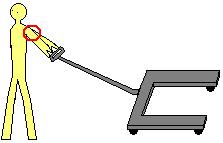How-To: Reducing Non-Neutral Shoulder Postures
Today, I will be continuing an ongoing series of primers to help our readers identify non-neutral body postures. Today's area of focus is the shoulder. The shoulder is a loosely-bound confluence of body structures, being the meeting place of the humerus (upper arm) and the clavicle (collarbone). As such, unnecessary work-related stress can put the joint at risk for injury.
There are 3 major situations where the shoulder can be found outside of its neutral orientation:
SHOULDER FLEXION
Problem: The work system/object in question is outside of the operator's optimal envelope of reach (12"), forcing them to reach forward, putting their shoulder into a position known as flexion.
Solution: Bring the work system/object closer to the operator so that they are within 12" optimally, and no further than 18". Eliminate/reduce any physical barriers that prevent the operator from getting sufficiently close to their work, provided that eliminating that physical barrier does not compromise safety.
SHOULDER EXTENSION
Problem: The operator interacts with work systems/objects behind them out of neccesity/habit, or pulls a cart instead of pushing it.
Solution: Situate the work systems/objects in front or the side of the operator, placing the controls/objects within 12" of the operator optimally, and no more than 18" overall. Have the worker use a push cart rather than one that is pulled, as it uses larger muscle groups than pulling does, thus reducing the damaging effects of chronic muscle fatigue (Source: OSHA)
SHRUGGED SHOULDERS
Problem: The work surface is too high for the work being performed on it, causing the operator to shrug their shoulders. Work systems/objects accessed above shoulder level also causes shrugging of the shoulders.
Solution: Adjust the working height so that fall within the parameters of the work that is being performed. The work surface should be between 37.5" - 47" for precision tasks, 33.5" - 43" for light work, and 26" - 37" for heavy work (Source: CCOHS). All work surfaces should be fully adjustable to allow for appropriate micro adjustments. All work systems/objects should be accessible below shoulder level as much as humanly possible.

0 Comments:
Post a Comment
Subscribe to Post Comments [Atom]
<< Home